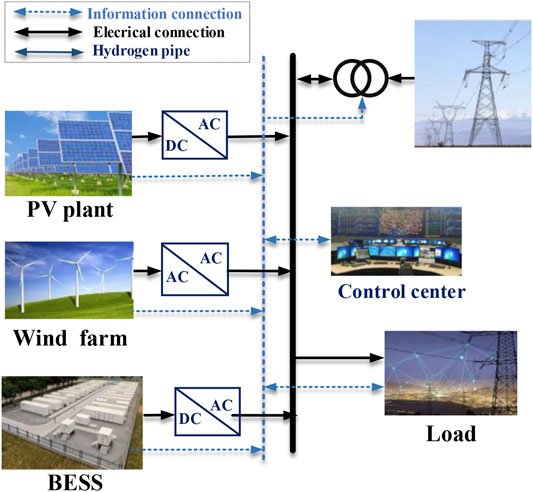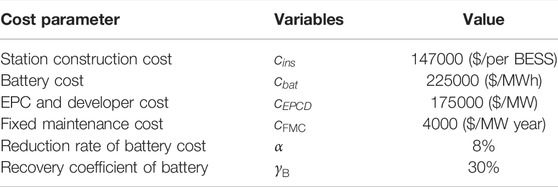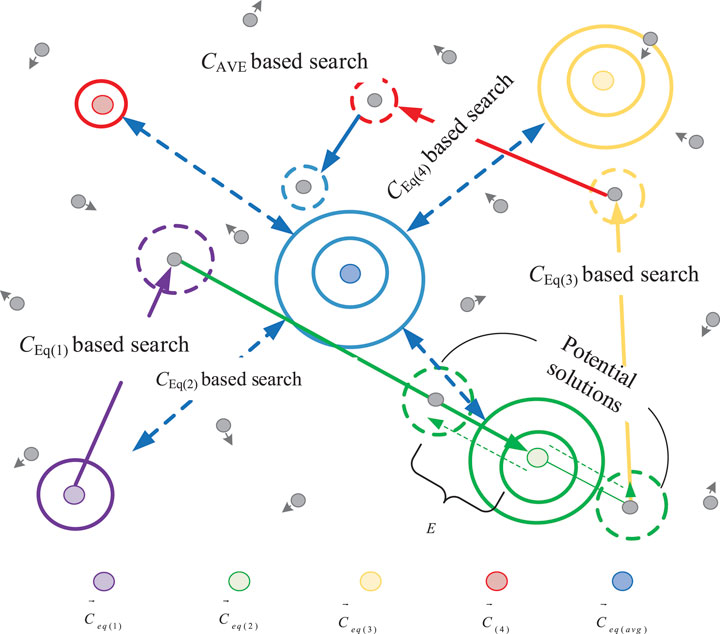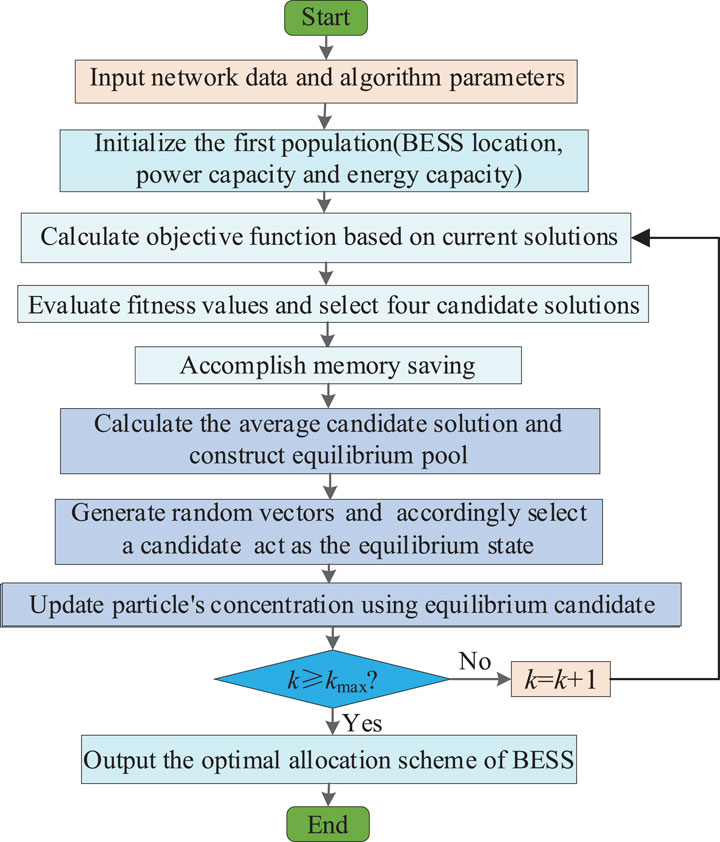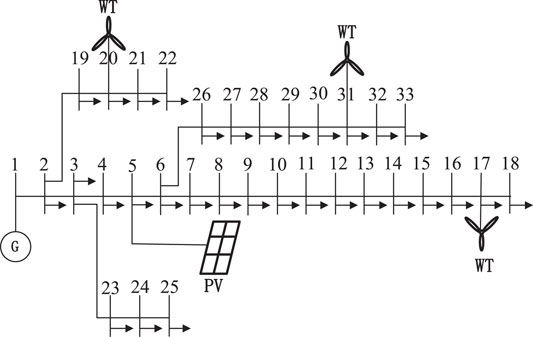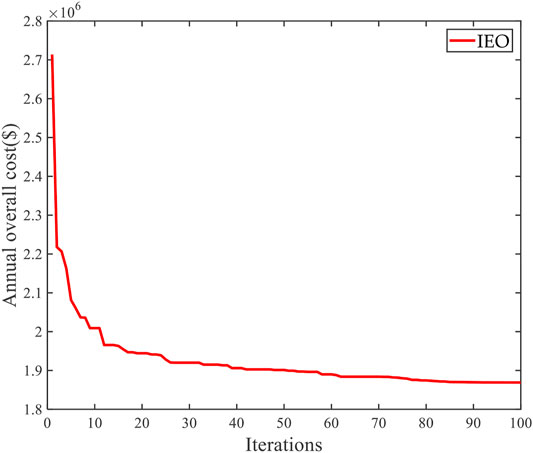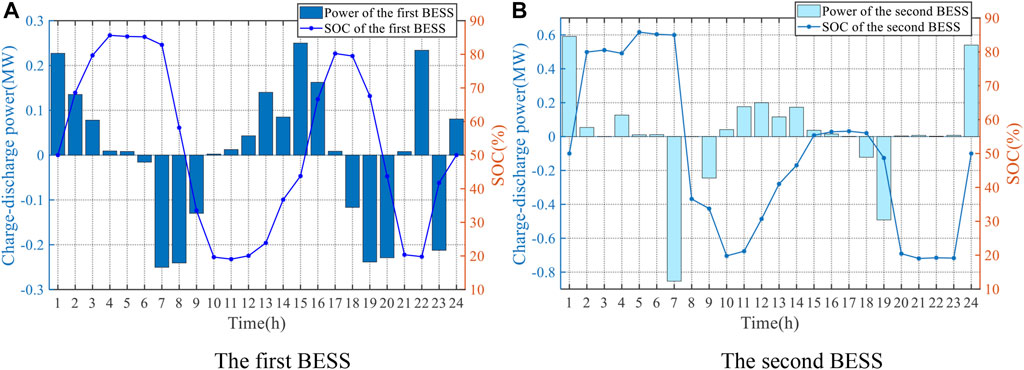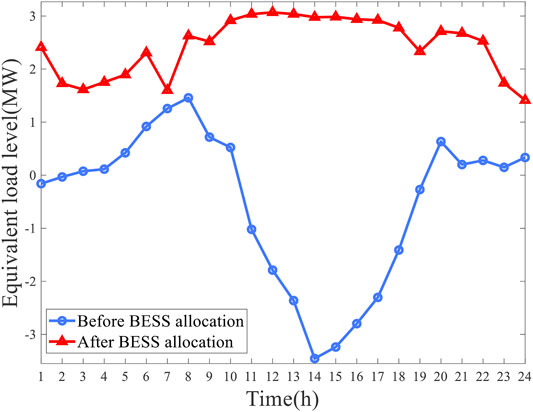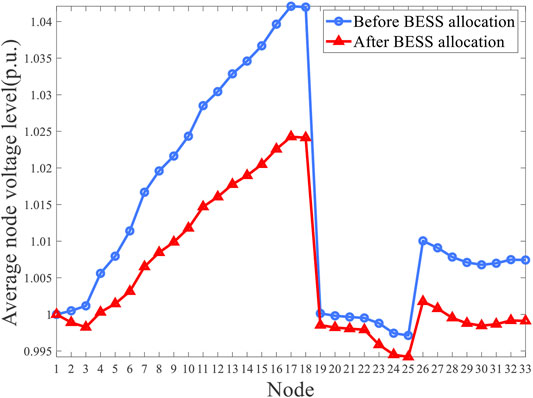- 1School of Computer Science and Technology, Beijing Institute of Technology, Beijing, China
- 2Yunnan Provincial Energy Investment Group Co., Ltd., Kunming, China
The battery energy storage system (BESS) can accommodate the uncertainties of renewable energy sources (RESs) and load demand. Proper allocation of the BESS in the distribution network (DN) can bring cost-effectiveness and enhance system stability. To realize the reliable and economic operation of BESS in the DN, a multi-objective optimization model for optimal BESS allocation is established, which aims at minimizing the annual overall cost of the whole system, including life cycle cost (LCC), power loss cost, peak-shaving cost, tie-line fluctuation penalty, and voltage deviation penalty. Then, a novel implementation of the improved equilibrium optimizer (IEO) algorithm is proposed to solve the optimal BESS allocation scheme. In order to verify the effectiveness of the proposed method, the simulation experiment based on the IEEE 33-bus test system is performed. Simulation results prove that the IEO algorithm is capable of rapid stable convergence and efficient searching for optimum in the multidimensional space. By the end of the iteration, the annual overall cost of the whole system records a minimum value of $1.8692e+06 every year. A meticulous techno-economic analysis demonstrates that the obtained BESS allocation scheme not only effectively ensures cost-effectiveness of BESS but also significantly reduces power loss, load peak-valley difference, tie-line power fluctuation, and voltage deviation.
1 Introduction
With rapid expansion of global economy, excessive exploitation and utilization of various traditional fossil fuels has aggravated ecological environment degradation in the past few decades, which significantly hinders the world’s sustainable and stable development (Yang et al., 2018; Zhang et al., 2019a). To solve this thorny issue, a variety of renewable energy sources (RESs) such as wind, solar, and wave energy have obtained widespread concerns (Yang et al., 2021). However, due to the intermittent and randomness of RESs, the integration of a significant amount of RESs into power grids will pose crucial challenges to the safe, stable, and economical operation of the system such as load peak-valley difference, tie-line power fluctuation, voltage violation, RESs curtailment, and line congestion (Das et al., 2018; Guchhait and Banerjee, 2020).
The battery energy storage system (BESS) is not only regarded as one of the most promising candidates for adjusting energy structure and building an environmentally friendly world due to its prominent advantages, for example, high energy conversion efficiency, reliable operation stability, and emission-free (Luburić et al., 2018) but also BESS has been a viable solution which can provide diverse economic benefits and technical support to different power system stakeholders, especially distribution network (DN), including power loss reduction, stability enhancement, and congestion alleviation (Luo et al., 2015). In addition, the BESS can provide an effective supplement for RESs in smoothing output fluctuations.
However, optimal placement and sizing of the BESS are two crucial factors to ensure satisfactory performance of BESS application. Given this, considerable research studies have been carried out either in BESS allocation models or solution algorithms (Yang et al., 2020). Nazaripouya et al. (2015) performed voltage sensitivity analysis to optimize the best placement and sizing of the BESS, where voltage regulation in the presence of RESs is achieved. In the study by Zakeri and Syri (2015), the dynamic programming method is used to plan the BESS in a low-voltage grid so as to minimize power loss. However, such traditional methods as analytical methods and mathematical optimizations consume a long time to converge due to computational complexity and easily trap at local optimum and so has low solution efficiency and accuracy. BESS planning is a complex nonlinear optimization problem with discrete optimization variables, and it is difficult to solve the problem effectively with the abovementioned numerical methods. Meta-heuristic algorithms are popular for various optimization problems by means of their merits of model-free, minimal storage requirement, high convergence rate, and strong search ability (Iba, 1994; Jayasekara et al., 2016). In the study by Kerdphol et al. (2016), particle swarm optimization (PSO) is implemented to obtain optimum sizing of the BESS with high economic profitability. In the study by Wong et al. (2019), a whale optimization algorithm is introduced to optimize placement and sizing of the BESS for power loss reduction, while the performances of these algorithms do not achieve huge breakthroughs. Also, most of the literature only has a single technical benefit or economic benefit.
Therefore, this study establishes a multiobjective mathematical model for BESS optimal allocation, in which life cycle cost (LCC) of the BESS, power loss, peak-shaving effect, tie-line fluctuation, and voltage deviation of the DN are comprehensively considered. In order to solve this model, a novel metaheuristic algorithm, improved equilibrium optimizer (IEO), is proposed to search an optimal solution for the BESS allocation strategy. The proposed algorithm owns advanced updating mechanisms of searching agents, which can effectively avoid falling into local optimum and reach significant improvement on search ability. To verify the effectiveness, the proposed model and algorithm are implemented in the extended IEEE-33 bus test system.
The remaining of this article is organized as follows: Section 2 is system description of the BESS connected to the power grid; Section 3 develops the optimal allocation model of the BESS; the IEO algorithm for the model solution is introduced in Section 4; Case studies are undertaken in Section 5; Section 6 summarizes the main contributions of this study.
2 System Description
The schematic diagram for BESS access to the power grid is shown in Figure 1. The energy storage controller controls the fast charging/discharging operation of the BESS via real-time monitoring operation condition of the system so as to realize energy exchange between the BESS and the power grid. The remaining charge of the BESS at any moment, namely, the state of charge (SOC) is an important parameter to characterize the charging/discharging operation of the BESS. This relationship needs to be taken into account in the optimal configuration model of the BESS, and rated capacity and charging/discharging power of the BESS are regarded as control variables. SOC of the ith BESS at time t is calculated as follows (Farrokhifar, 2016):
The power exchanged between the BESS and power grid can be expressed as
It should be noted that charging power and discharging power at the same time are mutually exclusive, so the power exchange between the BESS and the power grid must be satisfied as follows:
3 Optimal Allocation Model of the Battery Energy Storage System
In this study, the allocation of the BESS of the DN is expected to minimize investment and operation costs of the BESS, power loss, peak-valley difference of load and tie-line power fluctuation, and voltage deviation. Therefore, a high-dimensional multi-objective optimization model is established. Here, it is considered that all goals are of equal importance, and thus a simple weighting method is adopted to simplify this multi-objective model. Therefore, the optimal allocation model of the BESS that takes annual overall cost including the previously mentioned expenses as the optimization objective is as follows:
where
3.1 Objective Functions
3.1.1 Life Cycle Cost
Life cycle cost (LCC) is an important indicator to evaluate the economy of the BESS, which accommodates all the expenses expected to occur during the lifetime of the BESS, such as total capital cost (TCC), maintenance cost (MC), operation cost (OC), replacement cost (RC), and disposal and recycling cost (DRC) (Zakeri and Syri, 2015). From an ownership perspective, it is crucial to perform a comparative LCC analysis of the BESS. Here, LCC is mathematically formulated as annualized cost, as follows:
It should be noted that the main cost parameters of the BESS were taken from both the National Renewable Energy Laboratory (Ran et al., 2018), which are tabulated in Table 1.
3.1.1.1 Total Capital Cost of the Battery Energy Storage System
where
where
3.1.1.2 Maintenance Cost of the Battery Energy Storage System
MC of the BESS refers to the maintenance cost to ensure BESS operation, which is proportional to the rated power of the BESS, as follows:
where
3.1.1.3 Operation Cost of the Battery Energy Storage System
In terms of energy arbitrage of the BESS in the electricity market, the BESS is cost-effective if the algebraic sum of purchasing electricity cost and selling electricity income is a negative number. Annual
where T means 24 h in a day;
3.1.1.4 Replacement Cost of the Battery Energy Storage System
RC of the BESS is mainly from replaceable batteries, as follows:
where
3.1.1.5 Disposal and Recycling Cost of the Battery Energy Storage System
where
3.1.2 Power Loss Cost
The grid-connected BESS will change the power flow of DN (Injeti and Thunuguntla, 2020). Furthermore, different placement and sizing of the BESS will have different influences on power loss. For the sake of minimizing the total active power loss, the power loss index in the form of expenses is established in the optimization model, as follows:
where
3.1.3 Peak-Shaving Cost
where
3.1.4 Tie-Line Fluctuation Penalty Fee
Owing to the intermittency of RESs in their nature, the integration into the power grid poses significant power fluctuation in the grid connection point. However, the BESS can smooth power fluctuation brought from RESs to improve power stability (Sun et al., 2019). Tie-line power fluctuation in the form of expenses can be expressed as
where
3.1.5 Voltage Deviation Penalty Fee
To ensure the power quality of DN, node voltages should be stabilized at a certain level. Here, the penalty fee of voltage deviation encourages node voltages to the nominal voltage (Jayasekara et al., 2016), which is calculated as
where
3.2 Constraints
3.2.1 Power Balance
where
3.2.2 Range of Node Voltages
where
3.2.3 Power Limits of Grid Connection Point
where
3.2.4 Range of Battery Energy Storage System Capacity
where
3.2.5 Charging and Discharging Power Limits of the Battery Energy Storage System
3.2.6 State of Charge Limits of the Battery Energy Storage System
where
3.2.7 Charging Rate Limits of the Battery Energy Storage System
where C represents the current intensity of the BESS when it is fully discharged within 1 hour. The charging rate of the BESS is generally 0.5 C, 1 C, and 2 C, and the maximum is 4 C.
4 Model Solution Based on Improved Equilibrium Optimizer
The optimal allocation of the BESS is a highly non-convex optimization problem with high dimensions, multi objectives, and complicated constraints (Li et al., 2018). To solve this problem, an IEO algorithm is designed in this study. The search mechanisms of the proposed IEO and the overall optimization procedure for BESS allocation are elaborated in this section.
4.1 Equilibrium Optimizer
4.1.1 Principle of EO
EO is a physics-based meta-heuristic algorithm, which was first presented by Faramarzi, Heidarinejad, et al. (2019) (Faramarzi et al., 2020). It is based on control volume mass balance models, and each particle with its concentration represents a searching agent. All searching agents randomly update their concentration based on an equilibrium candidate to reach an equilibrium state. The equilibrium candidate is regarded as the best solution.
In the EO algorithm, a generic mass balance formula in the first-order ordinary differential equation form is utilized to describe the physical process of mass entering, leaving, and generated in the control volume, as follows:
where
Then, Eq. 26 can be obtained by solving differential Eq. 25, as follows:
where λ is defined as turnover rate; C0 is the initial concentration at time t0; factor F is the exponential coefficient as Eq. 27.
4.1.2 Optimization Mechanism of EO
The optimization process of EO is performed based on Eq. 25. As for an optimization problem, concentration C on the left-hand side of the equation represents the current solution; Ceq denotes the best solution ever found. Similar to the speed updating mechanism of the PSO algorithm, concentration is regarded as the individual solution. The collaboration between different individuals for solutions updating in 2D dimensions is shown in Figure 2. The optimization mechanisms are designed as follows (Faramarzi et al., 2020):
4.1.2.1 Initialization
During the initialization stage, concentrations are generated by performing random initialization within the upper and lower bounds of each optimization variable, as follows:
where
4.1.2.2 Equilibrium Pool and Candidates
In order to improve the global search ability of EO and effectively avoid local optimum stagnation, the ultimately convergent equilibrium state contains four best-so-far particles, which are defined as equilibrium candidates, all of which constitute an equilibrium pool:
where
4.1.2.3 Exponential Term F
Exponential term F is crucial to properly balance global exploration and local exploitation during concentration updating, which is expressed as
where
where
To effectively avoid premature convergence, the following is also considered, as follows:
where a1 denotes a constant value adopted for an adjustment between global search and local exploitation; sign is symbolic function;
Substituting Eq. 32 into Eq. 30, yields
It is noted that the higher the a1, the better the exploration ability and consequently the lower exploitation performance. Similarly, the higher the a2, the better the exploitation ability, and the lower the exploration ability. In addition, sign (r−0.5) affects the direction of exploration and exploitation.
4.1.2.4 Generation Rate G
Generation rate G is critical to improve the local exploitation stage, and G is devised as follows:
where
4.1.2.5 Solutions Update
Therefore, the overall updating rule of EO can be described by
4.2 Improved Equilibrium Optimizer
Compared with the original EO algorithm, different equilibrium candidates of the IEO algorithm are allocated by different selection probabilities to all equilibrium candidates according to their fitness values instead of randomly selecting an equilibrium candidate from the equilibrium pool. That is to say, an equilibrium candidate with a smaller fitness value will receive a higher selection probability, which can achieve a deeper exploitation modified equilibrium candidate assignment mechanism.
It should be noted that the fitness values of all equilibrium candidates are normalized to range from 0 to 1, and then the selection probabilities can be obtained by
where
Due to IEO dynamically adjusting equilibrium candidate selection probabilities based on their fitness value during iterations, it can implement deeper exploitation and improve overall optimization efficiency to search for a higher quality optimum.
4.3 Design of Improved Equilibrium Optimizer for Battery Energy Storage System Allocation Application
4.3.1 Optimization Variable Processing
The IEO individuals are characterized by the optimization variables, including installation placement, power capacity, and energy capacity of two BESSs, all of which need to be constricted in a reasonable range; otherwise, some negative effects on the power flow, relay protection, voltage, and waveform of the original power grid will be observed. In this study, nodes in the range of [2, 33] are selected as the installation node, in which environmental and geographical nodes need to be considered in engineering practice. In addition, the limits of power and energy capacities are determined to consider the topology of DN, the power limit of the interconnection point, and especially the total load power. Therefore, the power capacities allowed to access the power grid of two BESSs are determined so as to satisfy the total active power load of the power grid. In order to give full play to the charging and discharging capacity of the BESS, the ratio of energy capacity limit to power capacity limit is 4 to 1, as follows:
where
It should be noted that these four variables, that is, power and energy capacities of two BESSs are continuous, while these two variables, that is, installation placement are discrete. In this study, continuous variables can converge to the optimal value in the iteration process, while the optimal value of discrete variables is needed to be rounded in the continuous space (Zhang et al., 2017).
4.3.2 Fitness Function Processing
The fitness function should be combined with the objective function and constraint conditions of the BESS optimal allocation model. First, the updated solutions will perform power flow calculation, where constraints need to be satisfied, that is, Eqs. 18–24. Then, objective functions of all solutions are evaluated based on the results of the power flow calculation. Once the constraint condition is not satisfied, a large penalty factor will be added to the objective function. Therefore, the fitness function can be designed as follows:
where η is the penalty factor for violating constraints, generally set to a larger normal number, and q means the number of unsatisfied constraints.
4.3.3 Solving Procedure of the Model
To sum up, the execution procedure of IEO for BESS optimal allocation is given in Figure 3.
5 Simulation Model and Case Study
5.1 The IEEE-33 Test System
In this section, BESS optimal allocation is implemented in the extended IEEE-33 bus system for verifying the effectiveness of the proposed method. The topology structure of the test system with the total load of 3.715+j2.3 MVA is depicted in Figure 4 (Goswami and Basu, 1992). In addition, the population size of IEO is set to be 100, and the maximum iterations are set to be 100. Some specific parameters are set to the default values. Tables 1, 2, respectively, provide the main cost parameters of BESS and TOU electricity prices.
5.2 Case Data of Source and Load Sides
It is assumed that one PV plant and three wind power plants are in the DN, where the maximum generation limits of wind and PV are 3 MW and 2.5 MW, respectively. In view of the uncertainty of load, wind, and PV output powers, this study adopts load, wind, and PV power curves under different typical daily scenarios to represent the actual operation of DN in the whole year.
First, annual historical data of load, wind, and PV powers in one area are generated based on wind and PV output models. Furthermore, a C-means clustering algorithm (Askari, 2021) is used to obtain typical daily curves of load, wind, and PV power, where the temporal correlation of source and load sides is considered, and four typical scenarios are obtained via scene fitting, as demonstrated in Figure 5, which can accurately simulate the uncertainty of DN.
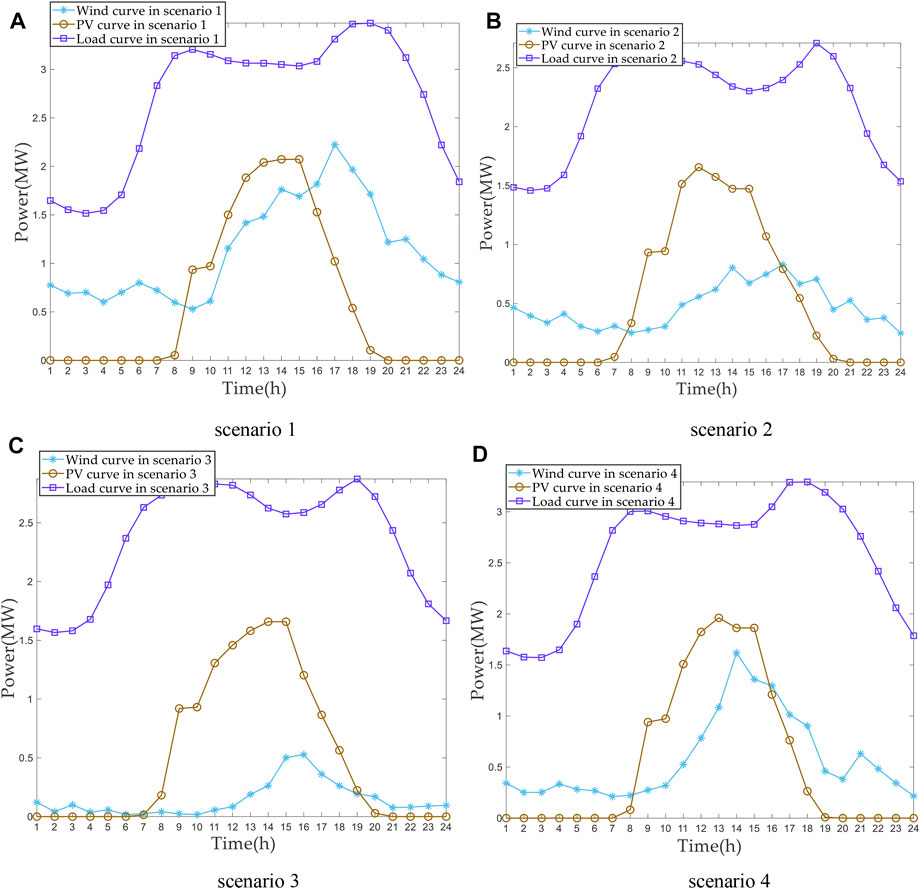
FIGURE 5. Clustered four typical operating scenarios. (A) Scenario 1. (B) Scenario 2. (C) Scenario 3. (D) Scenario 4
5.3 Simulation Results and Analysis
In order to prove the convergence performance of the proposed algorithm, taking annual overall cost as optimization objective, the optimization history (convergence curve) of optimal individual fitness of the IEO algorithm is presented in Figure 6. This metric is the fitness of the best-so-far particle Ceq (1) from the first to the last iteration. It can be seen that the proposed algorithm can converge to the minimum value with fewer iterations to avoid falling into the local optimum, which is a benefit by the design of the exponential term.
BESS optimal allocation scheme and optimization results of DN obtained by IEO algorithms are given in Table 3. The results show that the allocation scheme is the most cost-effective when the BESSs with the capacities of 0.2504 MW/1.0015 MWh and 0.8535 MW/1.7069 MWh, respectively, are installed in bus 32 and bus 7. The annual overall cost including power loss cost, peak-shaving cost, tie-line fluctuation penalty fee, and voltage deviation penalty fee, is only $1.8692e+06 in the case of the BESS for 15 years in the DN with a high proportion of RESs, of which LCC of the BESS is $-7.4236e+04. It is obvious that two BESSs are expected to achieve a total profit of $1.1135+06 in the lifecycle, even where the ancillary services of the BESS in the electricity market are not considered.
In addition, the obtained allocation scheme of the BESS by means of the IEO algorithm can help guarantee two BESSs operate at the optimum conditions with optimal placement and sizing in terms of economic and reliability requirements of DN. Figure 7 shows the charge–discharge power and SOC of two BESSs. It can be seen from Figure 7 that SOC gradually increased with the charge of the BESS and decreased with the discharge of the BESS, all of which are kept at 50% at the start and end of the day to ensure continuous and stable operation.
In order to verify the technical and economic benefits of the BESS, Table 4. provides several criteria of DN in two cases and the corresponding improvement rate. In particular, the annual total power loss of DN reduces by 538.5 MW when two BESSs are properly allocated in DN based on the proposed method, the maximum peak-valley difference decreases to 2.9097 MW from 8.6214 MW, and the improvement rates of average tie-line power fluctuation and average voltage deviation reach 47%.
In addition, equivalent load curves and average node voltage curves of DN under two cases are shown in Figures 9, 10. It is obvious that reasonable BESS planning can significantly reduce peak-valley difference and load fluctuation and improve voltage level.
6 Conclusion
In this study, a new method for determining the placement and sizing of the BESS, with the purpose of economy and reliability improvements in the DN, has been proposed. The contributions of the proposed method are drawn as follows:
● A multi-objective BESS allocation model takes economic criteria that incorporate time value into costs and technical criteria that relate to system reliability into consideration is established, which aims at achieving excellent cost-effectiveness and reliable operation of DN with RESs and BESS. Economic criteria accommodate all the expenses expected to occur during the lifetime of the BESS. For the sake of a common dimension of objective function, technical criteria are quantified by a dollar value, that is, power loss cost, peak-shaving cost, and the penalty fees of tie-line fluctuation and voltage deviation.
● A solution algorithm based on IEO is proposed to solve the BESS allocation model, whose specific application and design process are given. Compared with EO, the proposed IEO improves global search ability due to the fact that it dynamically adjusts equilibrium candidate selection probabilities rather than random selection of equilibrium candidate from equilibrium pool, which owns strong global search ability and good convergence effect, and thus can quickly search high-quality optimum solution.
● The multi-scenario clustering using a C-means clustering algorithm is conducted to capture the time-variable natures and uncertainties related to RESs and load demand. Ultimately, four typical scenarios are obtained via scene fitting according to the probability distribution of different scenarios. Compared to the direct average for seasonal data of source and load sides, the scenario clustering and fitting adopted in this study can more accurately simulate the actual operation condition of the DN, meanwhile balancing the simulation accuracy.
● To achieve practical study and verify the effectiveness of the proposed model and IEO algorithm, a procedure has been demonstrated on the extended IEEE-33 bus test system, which effectively verifies the optimality of the solution found. The optimal BESS allocation strategy obtained by the IEO algorithm converges to the lowest overall cost, which substantially reduces power loss, peak-valley difference, tie-line fluctuation, and voltage deviation. Hence, it is concluded that the proposed method is capable of finding the appropriate placement and sizing of the BESS and is beneficial for DN to increase economic efficiency and improve system reliability.
The future research work is devoted to investigating smart charging/discharging operations and suitable grid-connected control strategy of the BESS to be applied in real-time networks so as to facilitate BESS planning.
Data Availability Statement
The original contributions presented in the study are included in the article/Supplementary Material; further inquiries can be directed to the corresponding author.
Author Contributions
WZ: writing—reviewing and editing; SL: supervision and fundings.
Funding
The work is funded by the National Natural Science Fund of China (62076027).
Conflict of Interest
Author WZ was employed by Yunnan Provincial Energy Investment Group Co., Ltd.
The remaining author declares that the research was conducted in the absence of any commercial or financial relationships that could be construed as a potential conflict of interest.
Publisher’s Note
All claims expressed in this article are solely those of the authors and do not necessarily represent those of their affiliated organizations, or those of the publisher, the editors, and the reviewers. Any product that may be evaluated in this article, or claim that may be made by its manufacturer, is not guaranteed or endorsed by the publisher.
Reference
Askari, S. (2021). Fuzzy C-Means Clustering Algorithm for Data with Unequal Cluster Sizes and Contaminated with Noise and Outliers: Review and Development. Expert Syst. Appl. 165, 113856. doi:10.1016/j.eswa.2020.113856
Das, C. K., Bass, O., Kothapalli, G., Mahmoud, T. S., and Habibi, D. (2018). Overview of Energy Storage Systems in Distribution Networks: Placement, Sizing, Operation, and Power Quality. Renew. Sustain. Energy Rev. 91, 1205–1230. doi:10.1016/j.rser.2018.03.068
Faramarzi, A., Heidarinejad, M., Stephens, B., and Mirjalili, S. (2020). Equilibrium Optimizer: A Novel Optimization Algorithm. Knowledge-Based Syst. 191, 105190. doi:10.1016/j.knosys.2019.105190
Farrokhifar, M. (2016). Optimal Operation of Energy Storage Devices with RESs to Improve Efficiency of Distribution Grids; Technical and Economical Assessment. Int. J. Electr. Power & Energy Syst. 74, 153–161. doi:10.1016/j.ijepes.2015.07.029
Goswami, S. K., and Basu, S. K. (1992). A New Algorithm for the Reconfiguration of Distribution Feeders for Loss Minimization. IEEE Trans. Power Deliv. 7 (3), 1484–1491. doi:10.1109/61.141868
Guchhait, P. K., and Banerjee, A. (2020). Stability Enhancement of Wind Energy Integrated Hybrid System with the Help of Static Synchronous Compensator and Symbiosis Organisms Search Algorithm. Prot. Control Mod. Power Syst. 5 (2), 138–150. doi:10.1186/s41601-020-00158-8
Harvey, H. L. D. (2020). Clarifications of and Improvements to the Equations Used to Calculate the Levelized Cost of Electricity (LCOE), and Comments on the Weighted Average Cost of Capital (WACC). Energy 207, 118340. doi:10.1016/j.energy.2020.118340
Iba, K. (1994). Reactive Power Optimization by Genetic Algorithm. IEEE Trans. Power Syst. 9 (2), 685–692. doi:10.1109/59.317674
Injeti, S. K., and Thunuguntla, V. K. (2020). Optimal Integration of DGs into Radial Distribution Network in the Presence of Plug-In Electric Vehicles to Minimize Daily Active Power Losses and to Improve the Voltage Profile of the System Using Bioinspired Optimization Algorithms. Prot. Control Mod. Power Syst. 5 (1), 21–35. doi:10.1186/s41601-019-0149-x
Jayasekara, N., Masoum, M. A. S., and Wolfs, P. J. (2016). Optimal Operation of Distributed Energy Storage Systems to Improve Distribution Network Load and Generation Hosting Capability. IEEE Trans. Sustain. Energy 7 (1), 250–261. doi:10.1109/tste.2015.2487360
Kerdphol, T., Fuji, K., Mitani, Y., Watanabe, M., and Qudaih, Y. (2016). Optimization of a Battery Energy Storage System Using Particle Swarm Optimization for Stand-Alone Microgrids. Int. J. Electr. Power & Energy Syst. 81, 32–39. doi:10.1016/j.ijepes.2016.02.006
Li, R., Wang, W., Chen, Z., and Wu, X. (2018). Optimal Planning of Energy Storage System in Active Distribution System Based on Fuzzy Multi-Objective Bi-level Optimization. J. Mod. Power Syst. Clean. Energy 6 (2), 342–355. doi:10.1007/s40565-017-0332-x
Luburić, Z., Pandžić, H., Plavšić, T., Teklić, L., and Valentić, V. (2018). Role of Energy Storage in Ensuring Transmission System Adequacy and Security. Energy 156, 229–239. doi:10.1016/j.energy.2018.05.098
Luo, X., Wang, J., Dooner, M., and Clarke, J. (2015). Overview of Current Development in Electrical Energy Storage Technologies and the Application Potential in Power System Operation. Appl. Energy 137, 511–536. doi:10.1016/j.apenergy.2014.09.081
Nazaripouya, H., Wang, Y., Chu, P., Pota, H. R., and Gadh, R. (2015). Optimal Sizing and Placement of Battery Energy Storage in Distribution System Based on Solar Size for Voltage Regulation. IEEE Power & Energy Society General Meeting, 1–5. doi:10.1109/pesgm.2015.7286059
Ran, F., Timothy, R., and Robert, M. (2018). Utility-scale Photovoltaics-Plus-Energy Storage System Costs Benchmark. Natl. Renew. Energy Lab. 10, 2172.
Sun, Y., Tang, X., Sun, X., Jia, D., and Zhang, G. (2019). Microgrid Tie‐line Power Fluctuation Mitigation with Virtual Energy Storage. J. Eng. 2019 (16), 1001–1004. doi:10.1049/joe.2018.8553
Wong, L. A., Ramachandaramurthy, V. K., Walker, S. L., Taylor, P., and Sanjari, M. J. (2019). Optimal Placement and Sizing of Battery Energy Storage System for Losses Reduction Using Whale Optimization Algorithm. J. Energy Storage 26, 100892. doi:10.1016/j.est.2019.100892
Yang, B., Wang, J., Chen, Y., Li, D., Zeng, C., Chen, Y., et al. (2020). Optimal Sizing and Placement of Energy Storage System in Power Grids: A State-Of-The-Art One-Stop Handbook. J. Energy Storage 32, 101814. doi:10.1016/j.est.2020.101814
Yang, B., Yu, L., Chen, Y., Ye, H., Shao, R., Shu, H., et al. (2021). Modelling, Applications, and Evaluations of Optimal Sizing and Placement of Distributed Generations: A Critical State‐of‐the‐art Survey. Int. J. Energy Res. 45 (3), 3615–3642. doi:10.1002/er.6104
Yang, B., Yu, T., Shu, H., Dong, J., and Jiang, L. (2018). Robust Sliding-Mode Control of Wind Energy Conversion Systems for Optimal Power Extraction via Nonlinear Perturbation Observers. Appl. Energy 210, 711–723. doi:10.1016/j.apenergy.2017.08.027
Zakeri, B., and Syri, S. (2015). Electrical Energy Storage Systems: A Comparative Life Cycle Cost Analysis. Renew. Sustain. Energy Rev. 42, 569–596. doi:10.1016/j.rser.2014.10.011
Zhang, H., Lu, Z., Hu, W., Wang, Y., Dong, L., and Zhang, J. (2019). Coordinated Optimal Operation of Hydro-Wind-Solar Integrated Systems. Appl. Energy 242, 883–896. doi:10.1016/j.apenergy.2019.03.064
Zhang, X., Yu, T., Yang, B., and Cheng, L. (2017). Accelerating Bio-Inspired Optimizer with Transfer Reinforcement Learning for Reactive Power Optimization. Knowledge-Based Syst. 116, 26–38. doi:10.1016/j.knosys.2016.10.024
Zhang, Z., Yu, T., Wang, D. Z., Zhenning, P., and Xiaoshun, Z. (2019). Optimal Solution of Time-Of-Use Price Based on Ensemble Learning for Electricity-Gas-Heat Commercial Building. Proc. CSEE 39 (1), 112–125. doi:10.13334/j.0258-8013.pcsee.181584
Nomenclature
Abbreviations
BESS Battery energy storage system
CRF Capital recovery factor
DN Distribution network
DRC Disposal and recycling cost
EPC Engineering, procurement, and construction
IEO Improved equilibrium optimizer
LCC Life cycle cost
MC Maintenance cost
RC Replacement cost
RESs Renewable energy sources
OC Operation cost
SOC State of charge
TOU Time-of-use
Variables
C Concentration in control volume that denotes current solutions of all particles
Ceq Concentration under an equilibrium state that denotes the best solution ever found
Ceq (avg) Mean concentration of four solutions
Ceq, pool Equilibrium pool contains four candidates and an equilibrium state
Keywords: distribution network, battery energy storage system, optimal allocation with techno-economic consideration, improved equilibrium optimizer, meta-heuristic
Citation: Zhang W and Wang S (2022) Optimal Allocation of BESS in Distribution Network Based on Improved Equilibrium Optimizer. Front. Energy Res. 10:936592. doi: 10.3389/fenrg.2022.936592
Received: 05 May 2022; Accepted: 07 June 2022;
Published: 15 July 2022.
Edited by:
Yaxing Ren, University of Warwick, United KingdomReviewed by:
Jiawen Li, South China University of Technology, ChinaYixuan Chen, The University of Hong Kong, Hong Kong SAR, China
Copyright © 2022 Zhang and Wang. This is an open-access article distributed under the terms of the Creative Commons Attribution License (CC BY). The use, distribution or reproduction in other forums is permitted, provided the original author(s) and the copyright owner(s) are credited and that the original publication in this journal is cited, in accordance with accepted academic practice. No use, distribution or reproduction is permitted which does not comply with these terms.
*Correspondence: Shuliang Wang, c2x3YW5nMjAxMUBiaXQuZWR1LmNu
 Weiwei Zhang1,2
Weiwei Zhang1,2 Shuliang Wang
Shuliang Wang